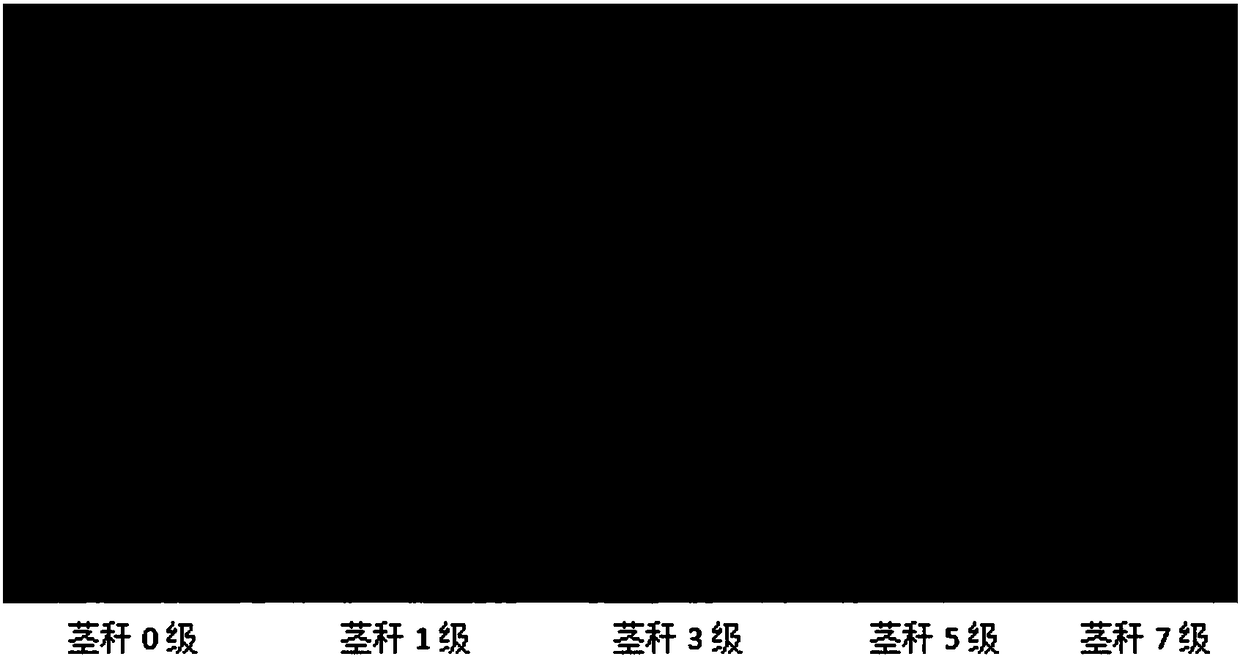Method for evaluating prevention and control effect of fungicide on black spot of sweet potato seedlings
A fungicide and black spot technology, applied in the field of evaluating the effect of fungicides on potato seedling black spot control, can solve the problems of many uncontrollable factors, unstable results, long test period, etc. cycle, the effect of improving the success rate
- Summary
- Abstract
- Description
- Claims
- Application Information
AI Technical Summary
Problems solved by technology
Method used
Image
Examples
Embodiment 1
[0045] Embodiment 1, the relation test of different inoculation concentrations and potato seedling susceptibility rate
[0046] Prepare concentration 5×10 5 spores / mL, 1×10 6 spores / mL, 1.5×10 6 spore / mL conidia suspension, inoculate different concentrations of conidia suspension according to the diseased soil preparation method as different treatments, 10 potato seedlings were cut in each nutrient pot, and each pot seedling was a repetition, and each treatment set 4 repetitions. After the cuttings are completed, put the nutrient bowl into the tray, put it in a 25°C incubator and cultivate it for 7 days, and then investigate the infection status. The results are shown in Table 1 and Table 2.
[0047] Table 1 Effects of different inoculation amounts on the susceptibility of potato seedling stems
[0048]
[0049] Note: Different lowercase letters after the data in the same column indicate significant differences at the 0.05 level, and different uppercase letters indicat...
Embodiment 2
[0053] Example 2. Comparison of control effects of potato seedlings treated with different concentrations of chlorothalonil against black spot under potted and hydroponic conditions
[0054] There are 6 treatments in total in the test, including blank control (no fungicide treatment) and 5 different concentrations of chlorothalonil agents, the concentrations of chlorothalonil are: 300mg / L, 400mg / L, 500mg / L, 600mg / L , 700mg / L. Each treatment was replicated 4 times, and each replicated had 10 potato seedlings. The potato seedlings were repeatedly placed in different concentrations of chlorothalonil liquid, and the seedlings were soaked at 25°C for 6 hours.
[0055] According to the method of embodiment 1, pot culture inserts each repeated cutting into a nutrient bowl and cultivates, and the conidia suspension inoculation concentration of diseased soil is 5 * 10 5 spores / mL. The hydroponic method is to transfer each repetition of potato seedlings to a separately placed spore s...
Embodiment 3
[0062] Embodiment 3, different concentrations of thiophanate-methyl treatment potato seedlings to the control effect test of black spot
[0063] There were 6 treatments in total in the test, including blank control (without fungicide treatment) and 5 different concentrations of thiophanate-methyl agents, the concentrations of thiophanate-methyl were: 300mg / L, 400mg / L, 500mg / L , 600mg / L, 700mg / L. Each treatment was replicated 4 times, and each replicated had 10 potato seedlings. The potato seedlings were placed in different concentrations of thiophanate-methyl medicinal solution according to the repetitions, and the seedlings were soaked at 25°C for 6 hours; according to the method of Example 1, each repeated cutting was inserted into a nutrient pot for pot culture, and the meristem of the diseased soil The inoculum concentration of the spore suspension was 5×10 5 spores / mL; after 7 days, investigate the black spot susceptibility and calculate the control effect, the results ...
PUM
| Property | Measurement | Unit |
|---|---|---|
| Depth | aaaaa | aaaaa |
Abstract
Description
Claims
Application Information
 Login to View More
Login to View More - R&D
- Intellectual Property
- Life Sciences
- Materials
- Tech Scout
- Unparalleled Data Quality
- Higher Quality Content
- 60% Fewer Hallucinations
Browse by: Latest US Patents, China's latest patents, Technical Efficacy Thesaurus, Application Domain, Technology Topic, Popular Technical Reports.
© 2025 PatSnap. All rights reserved.Legal|Privacy policy|Modern Slavery Act Transparency Statement|Sitemap|About US| Contact US: help@patsnap.com



